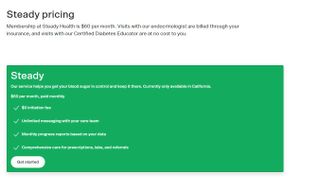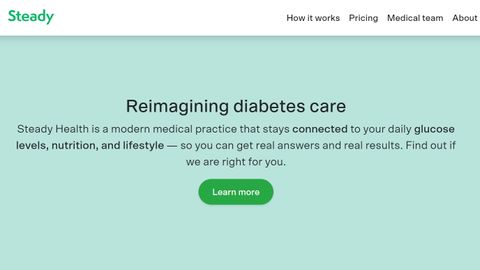TechRadar Verdict
Steady health takes a data centered, telehealth approach to managing a patient’s diabetes.
Pros
- +
Endocrinologist visits are covered by many insurers
- +
Certified Diabetes Educator sessions included
- +
Available mobile apps
- +
Voluminous data acquisition
Cons
- -
[Cons]
- -
Limited geographic area (California only)
- -
Limited support options
- -
Complicated cost structure with unknown device costs
- -
Video only visits
Why you can trust TechRadar
Over 10% of the US population has diabetes, and in the over 65 years old senior population, it exceeds 25%. With such staggering statistics, it is easy to see why Steady Health targets its telehealth service to just this single disease. This California based company, with a location in San Francisco, has an endocrinologist leading a multidisciplinary team with the goal of controlling a patient’s blood sugar through a variety of modalities.
Features
Steady Health takes a connected approach to managing a patient with diabetes. This focuses on having the patient use a connected glucose monitor (CGM), which can then acquire much more data than acquiring fingersticks with a digital handheld meter, which is traditionally used four times daily. Using technology, all of these glucose measurements can be uploaded for the providers of Steady Health to analyze.
The amount of data is quite voluminous, with over 100 glucose measurements daily, and over fifty-two thousand measurements on an annual basis. This continuous glucose monitor can provide data on how the patient responds to each of their daily activities, such as exercise, sleep, eating, etc.
Being able to deal with all of this data can certainly get overwhelming. Typically a patient will see their endocrinologist every three months or so, or in other cases a patient may not have access to a specialist and just have their diabetes managed by a primary care provider. With Steady Health, patients get much more frequent visits, and many see the endocrinologist twice per week, which is suggested at over 20x the regular frequency of interaction.
Steady Health monitors the data as it is acquired, and can get in touch with the patient as needed via messaging. Visits with the doctor occur over a video platform, avoiding the burden of traveling to see the physician. They can also remind patients to receive their other routine checkups that can be quite important for the ongoing management of a diabetic patient. Assistance is also provided to refill prescriptions, and to organize forms.

Drawbacks
There are mobile apps available on both the Google Play and Apple stores with apps available for both the Android and iOS platforms.
A downside is that the reviews for Steady Health, while quite positive, are to put it nicely, sparse. For example, on the Android side of things, there are in fact no reviews of the app. This is likely due to the fact that the app has only been out for about a month at this point.
Things are only marginally better on the Apple side. The iOS app, while it has a 5 star rating, has only a handful ratings as well. Turning to social media, namely Facebook, yields an almost repeat situation with again only a handful of reviews, but once again a five star rating.
Support
Support for Steady Health is a little sparse, compared to some of its larger competition. To get in touch with them, it only lists an address for mail, a direct phone number, a fax number, and an email.
Neither of the phone numbers listed are toll free. Furthermore, we doubt most patients will use a fax or mail for support in our current connected times.
Unfortunately, it is missing some other possibilities, like an online portal, a FAQ, chat, webinars, or online videos.
Pricing
The cost of Steady Health is substantial, although the cost of untreated diabetes is going to be a lot more expensive.
Joining the Steady Health program for diabetes management is a commitment. It starts with an evaluation, which has a one time $300 (£242) cost for initial assessment. While this is a bit of a steep charge upfront, there is some value as it includes a Continuous Glucose Monitor (CGM), the first week of glucose tracking, and a “Personal glycemic report” to gain some understanding into how well your diabetes is controlled (or not).

After that, Steady Health is a subscription with a cost of $60 (£48) monthly. This includes no limit on communication with the providers at Steady Health, data analysis with progress reports on a monthly basis, and a comprehensive care plan with labs, referrals and prescriptions. Visits with the Certified Diabetes Educator are also covered. This monthly subscription is not covered by insurance, although it can be paid via some Flexible Spending Accounts to make it more manageable.
There are also visits with the Steady Health endocrinologist, Dr Calvin Wu. These visits are billed through insurance, and are subject to copays. Most insurance plans are reportedly accepted, such as Aetna, Cigna and Blue of California. For those out of network with the plans, the cost of the visit is $200 (£161).
Finally, be aware that the above costs do not include any medications, or the devices. While hardly surprising as most medications in healthcare are typically paid separately at a pharmacy, these continuous glucose monitors are medical devices which can have different costs to the patient depending on insurance, and need to be replaced at a set interval.
There is also a free trial offer for the first three months at no cost.
Final verdict
Steady Health is a telehealth practice that can manage a patient’s diabetes remotely, via a connected glucose monitor. The pros include the convenience of a video visit, the included Certified Diabetes Educator sessions, and the large amount of data collected and analyzed. The cons are the unclear costs of the CGM devices which need to be replaced, that the physician sessions are limited to just diabetes management only, and that this practice is limited to a single US state, namely California.
- We've also highlighted the best telemedicine software
Jonas P. DeMuro is a freelance reviewer covering wireless networking hardware.


